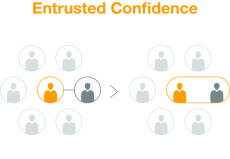December 5, 2014
Office workers have five key ways to get some peace and quiet at work
 According to a new study carried out by market researchers IPSOS and the Workspace Futures Team of office furniture maker Steelcase, office workers are desperately seeking privacy within open plan settings, where they can function effectively and complete work without being driven to distraction. As a result people are increasingly in need of more choice and control over how they work and are using a number of ways to seize it. Less than half of those surveyed (41 percent) claim they have the opportunity to undertake important work privately. The report claims that this does not mean that workers are looking to turn back the clock to the days of cellular offices because they ‘enjoy the buzz of the open plan office’ but are seeking peaceful retreats within them, depending on their own definition of what privacy means.
According to a new study carried out by market researchers IPSOS and the Workspace Futures Team of office furniture maker Steelcase, office workers are desperately seeking privacy within open plan settings, where they can function effectively and complete work without being driven to distraction. As a result people are increasingly in need of more choice and control over how they work and are using a number of ways to seize it. Less than half of those surveyed (41 percent) claim they have the opportunity to undertake important work privately. The report claims that this does not mean that workers are looking to turn back the clock to the days of cellular offices because they ‘enjoy the buzz of the open plan office’ but are seeking peaceful retreats within them, depending on their own definition of what privacy means.
In the research Steelcase were able to identify five key privacy needs for office workers:-
STRATEGIC ANONYMITY: Being unknown or “invisible” for a while in order to avoid normal social distractions and restraints. The opportunity to become invisible for a time is a key aspect of privacy. Going off radar makes workers feel that they are free of the restraints which come with normal social surveillance and which detract from concentration. Workers may choose to go to a café to get focused work done by blocking the social distractions of the workplace.
SELECTIVE EXPOSURE: Choosing what others see by being selective about the personal information and behaviours that we reveal. Today, as personal information is being shared across new channels, new questions are being raised about privacy and what is “safe” to divulge. While the decision to share information involves the weighing of benefits and risks, the choice varies from person to person. Examples of selective sharing can be opting for a telephone call instead of a video conference or choosing which personal items to display in a workstation.
ENTRUSTED CONFIDENCE : Sharing information confidentially within a trusting relationship. These workers need to have the opportunity to build up confidentiality where they feel that they must discuss a personal situation with a colleague or when in a performance review with their manager.
INTENTIONAL SHIELDING: Protecting yourself from others’ sight lines to avoid being observed or distracted, or to develop a personal point of view without the influence of others. Many office workers like to create a personal space using earphones to block out audio distractions or sitting back against a wall.
PURPOSEFUL SOLITUDE: Physically separating yourself from co-workers in order to concentrate, recharge, express emotions, rejuvenate or engage in personal activities. People in individualistic cultures, such as the UK, may take times of solitude almost for granted, but even within a collectivist culture, such as China, being alone is a fundamental need. These workers appreciate quiet spaces within the office or sit in the farthest empty corner of a large room.
Businesses and organisations are now facing the biggest challenge for a generation as they are asked to incorporate private spaces into office design. “People not only expect privacy in their private lives – they want it at the office as well”, say Bostjan Ljubic, of Steelcase. ”For people to collaborate with their colleagues more effectively they need less ‘we’ time and more ‘me’ time than they are getting today.”
“Because people experience privacy in these different ways, the key is to design a workplace that supports them all”, explains Ljubic. “Workplaces dominated by enclosed offices won’t solve the engagement problem. The best way to support today’s workers is to provide the ability to move between individual time and collaborative time, fully leveraging the power of the workplace to strengthen satisfaction and engagement.”
The Steelcase-IPSOS research claims to show that companies and organisations, while committed to creating efficient, collaborative spaces, have not been considering privacy sufficiently in the design of their offices. Steelcase contends that it is necessary to create an ‘ecosystem’ of different spaces where employees can choose the level of privacy they require.
“Many offices have limited options such as individual workstations, private offices, conference rooms and a cafe”, explains Ljubic. “Some people find it inspiring and creative to work in a crowded, noisy environment whereas others prefer quieter spaces and quite often they want a mix of both. The workplace needs to offer a variety of public and private spaces – for We and I work.”















